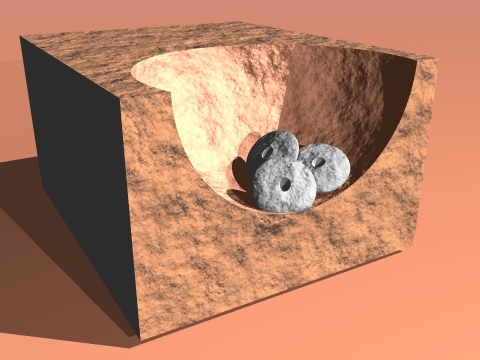A cache is a discrete group of items believed by the archaeologist to bave been deposited by ancient peoples at a single moment in time; a cache, then, is not an accumulation of items, representing several episodes of activity, but a depost resulting from a single, discrete action. This action, furthermore, deposited like or associated items. Several types of caches were found at Meier. A new weight cache (as shown above) was found in the northern 1/3 of the plankhouse, consisting of a neat stack of six basalt netweights. Other caches include deposits of lithic cores, hammerstones and antler tines (probably pressure-flaking tools), caches of deer metapodials (lower-limb bones used for making bone tools, such as points and awls) and caches of metal items, such as copper tubes (obtained from Euroamerican traders after contact in the early 1790's AD). Concentrations of beads may represent caches, or simply the loss of a beaded item. Caches may ofen have been deposited in bags or other containers which have decayed by the time of archaeological discovery.
Caches are fascinating features, because (if properly identified) they represent a very brief but meaningful moment in time, in which the mind of a person in the past is rather more 'accessible' than usual in archaeology: here we may observe what was considered to be associated with what; how many of such an item are deemed worthy of caching, suggesting their value, and so on. Theoretically, caches may also be used in the inference of abandonment behaviour, because people will cache different types of items depending on the circumstances of their leaving their residences. We are currently trying to distinguish between the older and more recent caches at Meier in an attempt to understand how the site was formed.
Back to Features

